| Theophanes Bathas | |
|---|---|
 Virgin & Child Virgin & Child | |
| Born | 1485-1490 Heraklion, Republic of Venice |
| Died | 1559 Heraklion, Republic of Venice |
| Nationality | Greek |
| Known for | Painter |
| Movement | Cretan School |
Theophanis Strelitzas (Greek: Θεοφάνης Στρελίτζας; 1490–1559), also known as Theophanes the Cretan (Θεοφάνης ὁ Κρής, pronounced Theophanes O Krees) or Theophanes Bathas (Θεοφάνης Μπαθᾶς) was a Greek painter of icons and frescos in the style of the Cretan School. He passed much of his career as a member of the monastic community of Mount Athos.
Theophanes was part of the artistically prolific Strelitzas-Bathas family, whose members have left over one hundred extant works distributed throughout Greece. His work influenced many later painters, including Fragkos Katelanos and Dionysius of Fourna. Theophanes's son and apprentice Symeon Bathas Strelitzas later became a professional painter in his own right.
History
Theophanes was born in Heraklion, Crete. His family, which originated in the Peloponnesus region, had been associated with painting for over a century. He was married and had two sons, Symeon and Nifos-Neophytos. Sometime before 1527 his wife died young and the family moved to Mount Athos, where Theophanes and his sons became monks and worked as painters.
Theophanes's work was sufficiently esteemed that he received a commission in the Great Lavra, the largest monastery at Mount Athos. He painted frescos in the main building of the complex, a Byzantine church dating back to 1004. The signature of Theophanes can be found in many parts of the building.
In 1536, Theophanes purchased a seat in Great Lavra Monastery for himself and his sons. He made an additional payment in 1540 and received a better location, with a vineyard and orchard. When his children were old enough he purchased the right for them to stay at the monastery with him. He also paid for his funeral in advance. Three years later Theophanes settled in Karyes, the administrative and commercial center of Mount Athos. He exchanged some of his property for a pyrgos, or tower, and meadows with orchards.
Historians believe that Theophanes traveled back and forth to Heraklion, and that he worked as a painter in the Meteora monastery of Saint Nicholas Anapausas and in the Chrysostomou Monastery of Cyprus. By 1552, records indicate he was in Heraklion. He died on February 24, 1559, having amassed a sizable fortune; his will, recorded the same day as his death, gave his two children silver, apartments in Heraklion, gold ducats, and other gold coins dating back to the Byzantine Empire.
The Bathas family was very important in the world of icon painting. The sons of Theophanes continued his legacy. Other relatives active around his lifetime were Markos Bathas, George Bathas, and Thomas Bathas, the last of whom participated in the decoration of the Venetian church of San Giorgio dei Greci.
Notable works
Frescos
- Narthex of the monastery of Agios Nikolaos, Meteora
- Stavronikita Monastery, Mount Athos
- The Great Lavra Monastery, Mount Athos
Icon paintings
- Icon of Jesus, Katholikon, the Great Lavra Monastery, Mount Athos
- Icon of Virgin Mary, Katholikon, the Great Lavra Monastery, Mount Athos
- 11 Icons of the Dodekáorto (Twelve feasts of the Eastern Orthodox Church), Katholikon, the Great Lavra Monastery, Mount Athos
Gallery
-
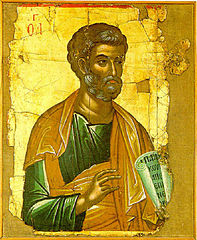 Apostle Peter - Stavronikita monastery, Mt Athos
Apostle Peter - Stavronikita monastery, Mt Athos
-
 Saint Paul 1546
Saint Paul 1546
-
 Jesus in Golgotha
Jesus in Golgotha
-
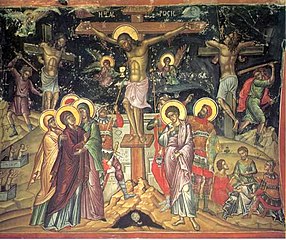 Crucifixion
Crucifixion
-
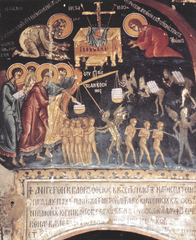 Virgin and Child
Virgin and Child
-
 The Ascension 1546
The Ascension 1546
-
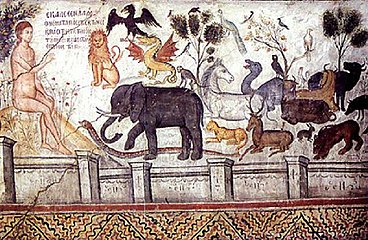 Adam naming the animals
Adam naming the animals
-
 Epitaphios (Lamentation of Christ) from Stavronikita monastery, Mount Athos.
Epitaphios (Lamentation of Christ) from Stavronikita monastery, Mount Athos.
-
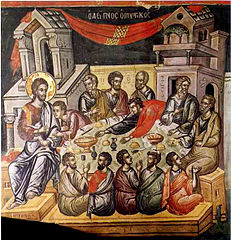 Last Supper, also from Stavronikita. Western influence is more apparent here, in the figures of the apostles especially.
Last Supper, also from Stavronikita. Western influence is more apparent here, in the figures of the apostles especially.
-
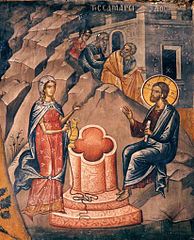 Jesus and the Samaritan Woman
Jesus and the Samaritan Woman
-
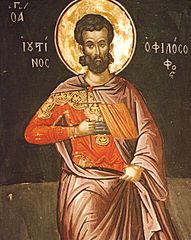 Saint Justin
Saint Justin
-
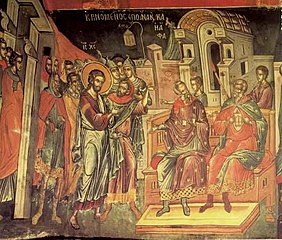 Jesus before Pontius Pilate
Jesus before Pontius Pilate
-
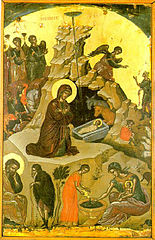 The Nativity Story
The Nativity Story
-
 Prophet Ezekiel
Prophet Ezekiel
-
 Washing of the feet
Washing of the feet
-
 St. John
St. John
References
- Hatzidakis, Manolis & Drakopoulou, Eugenia (1997). Greek painters after the fall (1450-1830) Volume B (PDF). Center for Modern Greek Studies E.I.E. pp. 381–396.
- Speake, Graham (2021). Encyclopedia of Greece and the Hellenic Tradition. London And New York: Rutledge Taylor & Francis Group. p. 1629-1630. ISBN 9781135942069.
- Eugenia Drakopoulou (June 28, 2021). "Strelitzas-Bathas Theofanis". Institute for Neohellenic Research. Retrieved June 28, 2021.
- Hatzidakis, 1997, pp 381-396
- Hatzidakis, 1997, pp 381-396
- Hatzidakis, 1997, pp 381-396
- Hatzidakis, 1997, pp 381-396
- Hatzidakis, 1997, pp 380-381
Bibliography
- Hatzidakis, Manolis (1987). Greek painters after the fall (1450-1830) Volume A. Center for Modern Greek Studies E.I.E.
- Hatzidakis, Manolis & Drakopoulou, Eugenia (1997). Greek painters after the fall (1450-1830) Volume B. Center for Modern Greek Studies E.I.E.
- Drakopoulou, Eugenia (2010). Greek painters after the fall (1450-1830) Volume C. Center for Modern Greek Studies E.I.E.
External links
- Byzantium: faith and power (1261-1557), an exhibition catalog from The Metropolitan Museum of Art (fully available online as PDF), which contains material on Theophanes the Cretan
 Media related to Theophanes the Cretan at Wikimedia Commons
Media related to Theophanes the Cretan at Wikimedia Commons- Article on his frescoes
- Theophanes of Crete in Byzantine art
| Cretan Renaissance | |
|---|---|
| Principal proponents | |
| Other artists | |
| Major works |
|
| Related | |